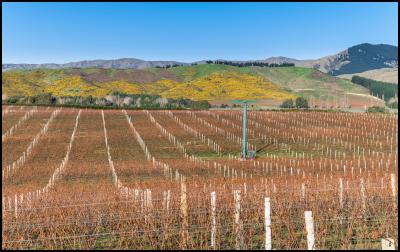Strong Kiwi dollar motivates Aussie investors to sell their New Zealand vineyard investments

The high value of
the New Zealand dollar has motivated the Australian owners
of several vineyards in the heart of New Zealand’s premier
sauvignon blanc grape growing region to place two of their
properties on the market for sale.
Both neighbouring vineyards are in the highly-fertile Waihopai Valley in Marlborough. The larger of the two vineyards is a 43 hectare holding – with almost 38 hectares planted in a mix of sauvignon blanc and pinot gris varieties. The second vineyard is a 36 hectare landholding planted in almost 24 hectares of sauvignon blanc grapes.
The vineyards are owned by separate entities – each set up by Australian investors in conjunction with Marlborough winemaker Ant Moore. Mr Moore is the New Zealand-based director of both companies. He entered Marlborough’s viticulture scene in 2002 as winemaker for Isabel Estate before going on to create his own self-titled label in 2006. The investors will continue to retain ownership of their three other vineyards.
Both the Waihopai Valley vineyards now for sale supply harvests for the Ant Moore label, along with other independent vineyards in the Awatere and Wairau valleys. The two Waihopai vineyards are being marketed for sale by negotiation through Bayleys Marlborough. Viticulture sales specialist John Hoare said the vineyards could either be bought individually or together.
Mr Hoare said the two vineyards were located immediately adjacent to the Omaka River. The larger of the two vineyards with its 85,000 vines produced more than 800 tonnes of grapes in the 2014 vintage. The vast majority of the harvest was sauvignon blanc. Its pinot gris grapes under the Ant Moore label have previously won gold medals at both the Liquorland Top 100 and Sydney International Wine Company wine competitions.
Infrastructure on the property includes two diesel-powered frost protection wind machines, a staff building, pump shed, and an implement shed. It is being sold with 10 shares in the Waihopai Irrigation Group scheme – allowing for the daily extraction of up to 180 cubic metres of water. The vineyard has additional consent to extract up to 396 cubic metres of water daily from the Omaka River.
Meanwhile, the adjoining vineyard produced more than 500 tonnes of grapes for crushing this year – with production at the vineyard having doubled since 2012. The second vineyard comes with one frost protection wind machine and 20 shares in the Waihopai Irrigation Group scheme.
“Both vineyards have ‘hit their straps’ over the past two seasons – with production up considerably on previous yields as the vines mature and cropping efficiencies improve,” Mr Hoare said.
“As a consequence of now becoming fully productive and delivering an ever-increasing tonnage, the Australian owner/investors of the two vineyards have chosen to implement their exit strategy – that is cashing up and repatriating the proceeds. This phase was always the part of he overall investment strategy for both operations.”
Mr Hoare said Ant Moore had expressed an interest in continuing to source grapes from both vineyards to continue supplying his brand and winery in the region. Mr Hoare said the two operations were currently jointly run under a single management and maintenance contract, which could either be continued in its current format, split, or dissolved.
“The grape supply contracts at both vineyards can be continued or terminated by negotiation – meaning the holdings can be bought as managed investments or as further production sources for existing wineries wanting to increase their capacity in, and from, the Marlborough region,” he said.
Mr Hoare expected that as a result of the configuration and location of the two sites, interest would most likely come from other Marlborough vineyard operators looking to add scale to their existing presence, and from international wine brands seeking to add to their sauvignon blanc capacity.
Sale of the vineyards is by negotiation.
ends



 Federated Farmers: Government Ends War On Farming
Federated Farmers: Government Ends War On Farming University of Auckland: NZ Researchers Drive Work On International AI Framework
University of Auckland: NZ Researchers Drive Work On International AI Framework Woolworths: Rolling Out Team Safety Cameras To All Stores As Critical Tool For De-escalating Conflict
Woolworths: Rolling Out Team Safety Cameras To All Stores As Critical Tool For De-escalating Conflict  Consumer NZ: Environmentally Conscious Shoppers At Risk Of Being Greenwashed
Consumer NZ: Environmentally Conscious Shoppers At Risk Of Being Greenwashed Hugh Grant: Facing The Future - The Use Of Biometric Tech
Hugh Grant: Facing The Future - The Use Of Biometric Tech John Mazenier: Gaffer Tape And Glue Delivering New Zealand’s Mission Critical Services
John Mazenier: Gaffer Tape And Glue Delivering New Zealand’s Mission Critical Services



